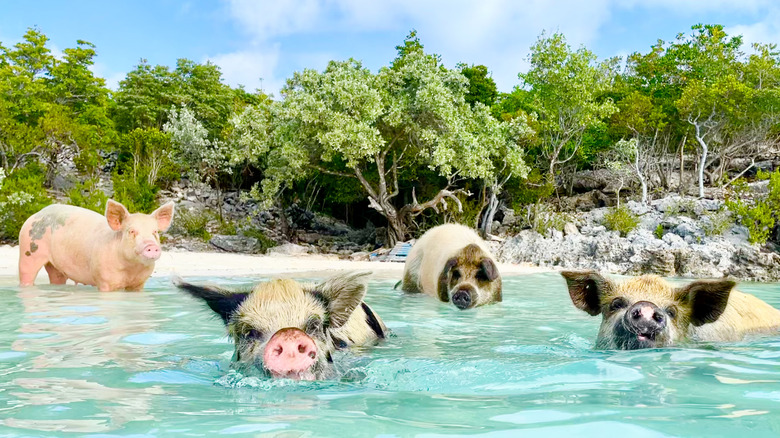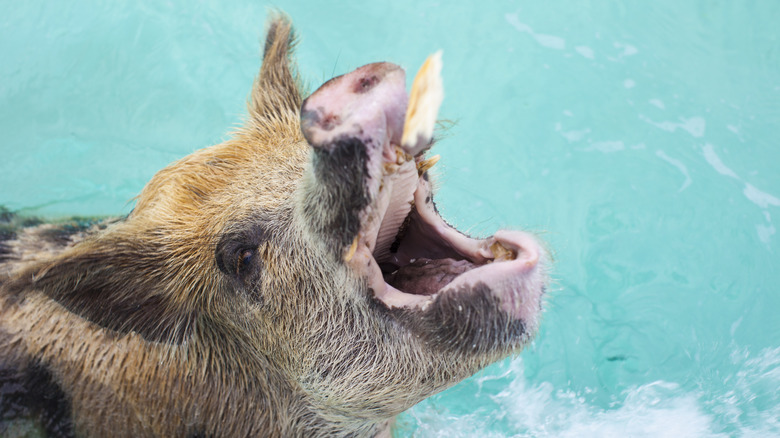Why You Should Think Twice Before Booking A Bahamas Swimming Pig Tour (And What To Do Instead)
If you've ever wondered, "Hey, where can I find me some pigs to swim with?" you might be shocked to learn that the Bahamas has got you covered. What started as five little pigs on Big Major Cay (aka, Pig Island) in the '90s has bourgeoned into an entire industry of tourists paying good money to swim side-by-side clusters of pigs in the same pristine, turquoise, shimmering Caribbean waters — basically what every farmer would gasp at. And if you're learning this for the first time and think that it sounds like a questionable idea, then your instincts are spot on.
Granted, there are plenty of reviews on sites like Tripadvisor calling the Bahamas' swimming pigs "cute" and "sweet" and swimming with them "cool" and "wonderful." Then there's the reviews that approach the experience without the gloss of the Bahamian sun, calling the pigs "gross" and "aggressive" and the experience "more hype than amazing." A lot of people mention one piggy behavior in particular, saying that they bite — a lot. Pictures of no-joke bruises attest to the truth of these claims, with one person saying that antibiotics were needed after-the-fact. Then there's reports of pigs carrying diseases like ringworm and ascariasis, and plenty of accusations of animal cruelty.
Bottom line: If you've got your heart set on booking a pig-swimming experience in the Bahamas, then go for it, but be aware of all of the above concerns. Alternatively, you can support an animal conservation center like the Ardastra Gardens and Wildlife Conservation Center or visit one of Baha Mar hotels' interactive animal experiences, where you can do things like see animals like sharks, sting rays, turtles, and starfish up close. No pigs, though, sorry.
Biting pigs, diseases, and animal welfare concerns
Domesticated or not, pigs aren't timid pushovers. Yes, they're sociable, inquisitive, can be affectionate, and are possibly smarter than dogs. They can also get ornery when afraid, threatened, or when they feel confined or when competing for resources. Females also get competitive for breeding rights and territory. In all cases, such stressors lead to biting, especially if mama and baby pigs are mixed together. So if the pigs in the Bahamas are biting people, it's not without reason.
This leads us to the animal welfare aspect of the whole industry. It might look cute when a piglet rushes up to a tourist wanting food, but that's only because it gets its food largely from tourists and has to compete. The pigs don't understand what's going on, and are sometimes confined in a pen before being chucked in the water and then scrambling to not drown and die. They do all this while their skin gets burned under the sun, sometimes to the point of being scabrous. And then there's the business side of things, where some would-be get-rich-quick folks might buy a couple piglets and the rest of a sow's annual litter just gets killed and eaten.
And finally, there's the disease angle. Pig feces and urine carry all sorts of bacterial diseases like leptospirosis, a blood infection, or cryptosporidiosis, which causes watery diarrhea. Then there's parasitic diseases like ringworm and ascariasis, a type of roundworm. While this all sounds grim, it's also just factual. If you're thinking of doing a little pig swimming on your trip to the Bahamas, all of this kind of information needs to be taken into account.
What to do instead of swim with pigs
If we were being glib about good alternatives to pig swimming in the Bahamas, we would just suggest swimming, minus the livestock. You could snorkel and dive in the blue waters of one of the Bahamas' lesser known islands, Mayaguana, known for its pristine beauty and secluded beaches. You could even go all out and connect to wildlife, not domesticated life, in the Exuma Cays Land and Sea Park, the oldest national park in the Bahamas. Or you could just hang out one of the best resorts in the Bahamas and duck into the pool now and then.
But if it's human-to-animal contact that you crave, coupled with full-body immersion in warm Caribbean waters, then you might be out of luck unless you bring your dog with you. Instead of that, you could always visit the Baha Mar hotel chain located on Nassau, a smallish island to the northeast of the Bahamas' main archipelago. They offer loads of animal interactions like yoga with flamingos, bird feeding, macaw meeting, and kid-friendly, educational activities. As we mentioned, there's the touch tank experience where you can see sharks, sting rays, and turtles up close and (gently) touch invertebrates in a little pool. All of these events need to be booked and are suitable for kids.
The Ardastra Gardens & Wildlife Conservation Centre, meanwhile, is the Bahamas only conservation center –– which makes it the perfect place to support. The center focuses on flamingos, which are native to the Bahamas, but their itinerary does include feeding some cute and fluffy bunnies from 2:30 p.m. to 3 p.m. every day.


